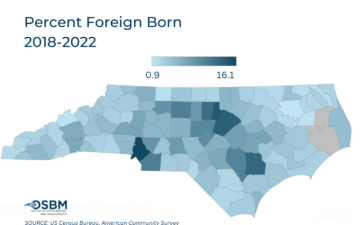North Carolina has set a goal for 2 million adults ages 25-44 in the state to have a postsecondary credential or degree by 2030; this represents about 67% of adults between the ages of 25-44 with a postsecondary certificate, diploma, or associate degree or higher.
Today, less than half of North Carolinians have such qualifications, and projections show the state’s current workforce will not meet the number of highly trained workers that will be needed to meet demands over the next decade.
In 2018, the John M. Belk Endowment asked Carolina Demography to examine North Carolina students’ education outcomes at public, in-state schools and indicate gaps where interventions could be implemented to meet the state’s increasing need for a highly trained workforce.
“We knew that less than half of working-age North Carolinians had earned a credential beyond a high school diploma,” says MC Belk Pilon, the president and board chair of the John M. Belk Endowment. “Still, much of the story remained unclear.”
In collaboration with the John M. Belk Endowment, Carolina Demography mapped out a complete picture of North Carolina’s postsecondary educational pipeline and identified the biggest opportunities for improvement.
We focused on the public education pipeline—meaning outcomes from K-12 (NC Department of Public Instruction), the North Carolina Community College system., and the University of North Carolina system. These institutions serve the majority of our state’s students and provided us with comprehensive data necessary to analyze student outcomes.
Using this data, we followed 9th graders in North Carolina through our state’s public education institutions for ten years and determined where they were most likely to drop out of the educational pipeline. We also examined how educational attainment across the state varies by demography and geography.
Our research showed that at every step in the pipeline, there are persistent differences in the likelihood of success by geographic location, sex, and race or ethnicity. The Belk Endowment has invited state policymakers to use the report to provide benchmarking and help guide public education interventions.
“It’s our hope that research like this can help us better understand how we’ve arrived at our current statewide attainment rate and inform opportunities to increase attainment so that more North Carolinians will be equipped with the knowledge and skills needed to succeed in our evolving labor market,” says MC Belk Pilon.
Interventions to address gaps in the education pipeline can take many forms. For instance, cost-effective interventions like providing resources to help students submit financial aid forms and making academic counseling services available during the summer have proven effective in addressing the transition from high school to college.
John M. Belk Endowment
To map out a complete picture of North Carolina’s postsecondary educational pipeline and identify the biggest opportunities for improvement

Last week, the U.S (United States). Census Bureau released 2023 county population estimates. These annual estimates tell us how county populations in North Carolina have changed over the course of a year: in this case, between July 1, 2022 and…

Deciding which educational pathway to pursue is often a daunting decision for a high schooler transitioning to postsecondary education. There are many questions a student must ask. Do I want to pursue a credential or a degree awarding program? What…

Dr. Michael Cline is the state demographer for North Carolina at the Office of State Budget and Management and has given us permission to re-post his content here. The original version of this piece is here. The foreign-born population in…
Your support is critical to our mission of measuring, understanding, and predicting population change and its impact. Donate to Carolina Demography today.